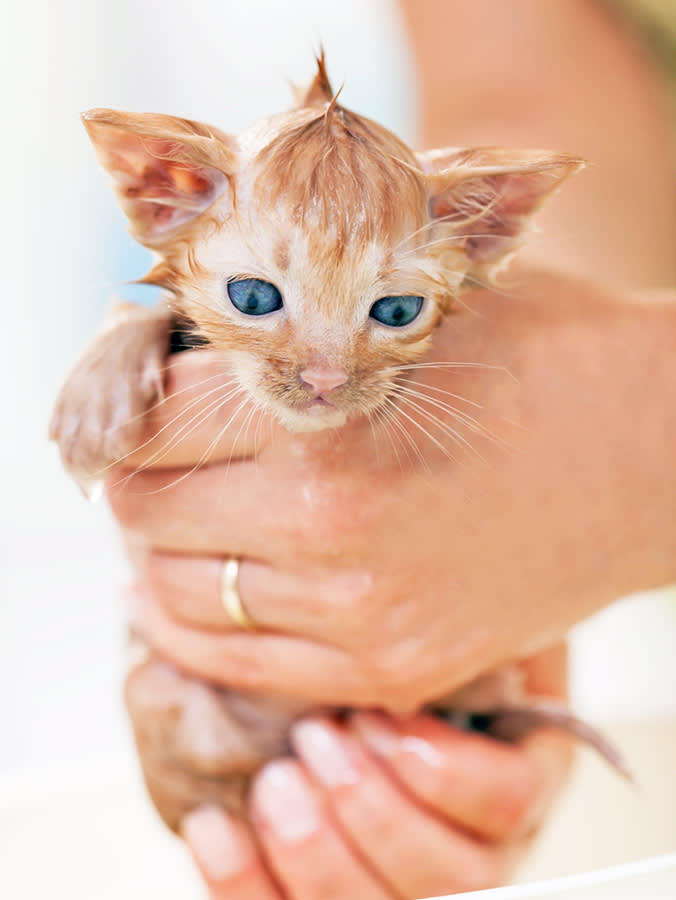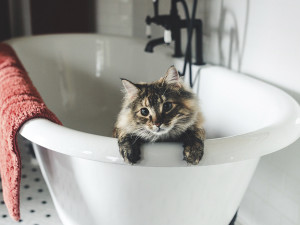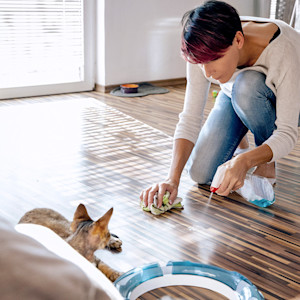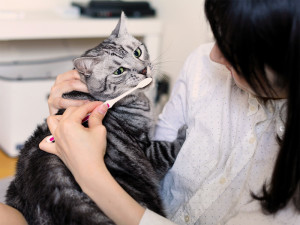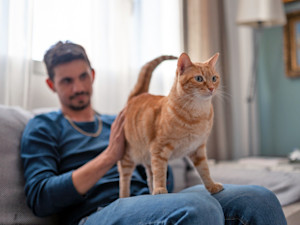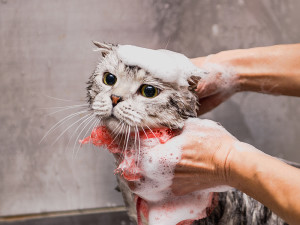Can You Bathe Your Kitten? A Step-By-Step Guide to Bathing Your Kitten Safely
Bathe your kitten safely and effectively.
In This Article:
Can You Bathe Your Kitten Bath Supplies Needed For Your Kitten Preparing to Bathe Your Kitten How To Bathe A Kitten (Step-by-Step) Safety Tips for Bathing Your Kitten Additional Tips for Bathing Kittens Frequently Asked Questions
There’s some controversy about whether cats hate water or not. While certain breeds of cats like it and even like to swim, most cats do not like to be fully immersed in water. They may enjoy playing with a few drops left in the shower or dripping from the sink faucet, but stepping into a tub of water is not something most cats want to do.
That said, sometimes your kitten may become soiled and need a bath. Even adult cats can need your assistance occasionally. This step-by-step guide to safely bathing your kitten will help you know how old your kitten has to be to have a bath, when a kitten or cat needs a bath, and the bathing process necessary to keep your kitten safe and comfortable.
Main takeaways
You can bathe a kitten if necessary.
Most cats never need a bath.
Dirt, playing in the litter box, and flea infestations are reasons to bathe a kitten.
Use only kitten shampoo when you bathe your kitten.
Getting the kitten dry and warm after the bath is essential.
Can you bathe your kitten?
You can bathe your kitten or even a full-grown cat. Giving a bath when a cat is a kitten may make it easier to wash them if needed when they are adults, and sometimes it’s necessary.
How much do you spend on your pet per year?
But when do they need a bath? What supplies do you need? What are the actual steps to follow when bathing your kitten? Read on, and you will find all the answers.
Age you can bathe a kitten
It’s best not to attempt to bathe a kitten younger than eight weeks of age unless it’s essential. Very young kittens are not equipped to regulate their body temperature, and they can become dangerously cold.
If your kitten is between eight and 12 weeks old, it is safe to bathe it, but use warm water, not hot water, keep the bath short, and be very gentle. Be sure to use towels and even a hair dryer if tolerated (on a low setting) to ensure the kitten is thoroughly dry and warm before ending the session.
How often should you bathe your kitten?
You really should only bathe a kitten or cat when it’s needed. There are a few instances when it may be quite necessary:
Flea infestations: Even a kitten younger than eight weeks may need a bath. Kittens that young can be crawling with fleas, and they are too young to use flea treatments or preventatives. Leaving the fleas on them is more dangerous than a bath. They can develop severe anemia and tapeworms.
Playing in the litter box: Kittens like to play, and rolling around in the litter box is something they don’t yet understand is not a good thing.
Vomiting or diarrhea: Many kittens have intestinal parasites which can make them sick or cause diarrhea. The results may call for a bath.
Dirt or sticky substances on their fur
Medical conditions requiring medicated baths: Examples include GI disturbances and parasites.
Do not overbathe your kitten just because you want them to smell better or you think you should if there are no problems. Overbathing can lead to a dry coat and skin.
Bath supplies needed for your kitten
Before you gather up your kitten for a bath, you should get all your supplies together:
Shampoo: Ensure it is kitten-safe (do not use dog or human shampoo). Read the label carefully, or better yet, ask your veterinarian. It’s best to use a shampoo without fragrance added.
A sink, a small basin, or a baby bathtub
A towel or non-slip mat to place in the bottom of the basin or sink.
A soft cloth for washing your kitten’s face and inside the ears
More than one soft towel to ensure the kitten is dry and warm afterward
A large plastic cup to use for rinsing off the shampoo
A kitten brush to use before and after the bath, especially if there are mats or tangled fur
Treats
Preparing to bathe your kitten
The first time you bathe a kitten or cat can be stressful. Preparation can help alleviate some of that stress:
Warm up the room where you’re giving the bath.
Have all your suppliesopens in new tab within arm’s reach so you don’t have to leave your kitten alone.
Brush any loose hair and debris from your kitten’s coat.
Place a towel or mat in the bottom of the sink or basin.
Fill the basin with warm water to the level of your kitten’s elbows and knees.
Have treats ready to reward good behavior and provide distraction.
You’re ready to bathe your kitten once you have all the supplies within arm’s reach.
How to bathe a kitten (step-by-step)
These are the steps to bathe your kitten (or cat).
Fill the sink or basin up to the kitten’s elbows.
Use warm water (not hot). Test the water on your wrist. Let the kitten hear the sound of the water while you’re comforting or giving a treat.
Place your kitten in the water and allow them to get comfortable.
Be gentle, but hold your kitten securely as you lower them into the water. Let them select the position they want to be in, sitting or standing.
Using kitten-specific shampoo, wash your kitten’s fur gently
Use the cup to wet their fur, except for their head, and then apply approximately a dime-sized amount of kitten-safe shampoo. Do not put shampoo on their face or in their ears, as getting water in the ears can lead to ear infections.
Gently massage the shampoo into your kitten’s fur to clean effectively.
Be gentle and use circular motions. Do not shampoo the face or ears. Use a soft, warm, wet cloth to clean the face and ears.
Rinse your kitten’s fur thoroughly
Use the cup to pour water over all areas of their fur where there is shampoo until no shampoo residue remains. Use a soft, damp cloth to clean the face and inside of the ears. Do not get water in the ears.
Gently pat your kitten dry with a soft towel
It may take more than one towel to completely dry your kitten. If they will tolerate it, a hair dryer on a low setting can also be used. It’s important they are not left wet, or they will get too cold.
If needed, use a brush or wide-tooth comb to detangle fur. This may be especially necessary for long-haired cats.
Post-bath care
Once the bath is complete, follow these steps to ensure your kitten remains comfortable and happy:
Warm environment: To prevent chills, keep your kitten in a warm, draft-free area until it is fully dry.
Reward and comfort: Offer a treat, cuddles, or playtime to reward them for their cooperation and to associate the bath with positive experiences.
Monitor for reactions: Watch your kitten for signs of discomfort, such as excessive scratching or redness, which could indicate a reaction to the shampoo. If you notice any issues, consult your veterinarian.
Follow the above steps, and you should have a clean, happy kitten in your hands.
Safety tips for bathing your kitten
Bathing a young kitten is absolutely possible if you follow the above guide. The most important thing is to keep them safe. Follow the tips below to make sure no harm is accidentally done.
Ensure the water is neither too hot nor too cold.
Never submerge your kitten fully in the water.
Do not pour water directly on their face; use a damp washcloth instead.
Keep the bath area quiet and calm.
Ensure your kitten is completely dry after the bath before exposing them to cooler temperatures.
The first time you give your kitten a bath, it can be a bit scary for both of you. Having a helper when you first begin bathing kittens is good. With practice, it can turn into a bonding situation.
Additional tips for bathing kittens
Frequency: Kittens generally don’t need frequent baths. Only bathe them when necessary, such as if they get into something messy or have fleas (in which case, use vet-approved flea treatments).
Desensitization: If your kitten is fearful of water, gradually introduce them to bathing by letting them play with water in a shallow dish or wetting their paws gently over time.
Emergency baths: If your kitten gets into a harmful substance, such as paint or chemicals, rinse them immediately with lukewarm water and contact your veterinarian for guidance.
With patience, the right supplies, and a calm approach, you can make bath time a safe and enjoyable experience for your kitten. Proper grooming keeps them clean, helps build trust, and strengthens your bond.
FAQs
Should you consider a professional groomer or do it yourself?
If you bathe your kitten carefully and use the right supplies, you can do it yourself most of the time. Professional groomers come in handy if your kitten turns out to be challenging due to fear, extreme dirt, or a flea infestation.
How to bathe a kitten without scaring them
If your kitten seems especially scared, you can start by giving them a very brief exposure to water only without shampoo or actually giving them a full bath. Speak in a very gentle voice. Try treats. Avoid sudden movement or loud noises.
Can I wash a kitten with Dawn?
It is best to use a shampoo made especially for kittens. In an emergency, such as oil or grease on the fur, you can use Dawn, but only the unscented Dawn original formula. Also, rinse thoroughly to avoid leaving residue behind, which can irritate their skin.
Should I give my kitten a bath?
You shouldn’t ever need to give a kitten or cat a bath since they are self-groomers unless they are dirty, smelly, or covered with fleas.
References
Carney, Hazel C, et al. “AAFP and ISFM Feline-Friendly Nursing Care Guidelines.” Journal of Feline Medicine and Surgery, vol. 14, no. 5, 17 Apr. 2012, pp. 337–349, https://doi.org/10.1177/1098612x12445002opens in new tab.
“When You Should—and Shouldn’t—Give Your Cat a Bath.” CVMBS News, 10 Mar. 2022, vetmed.tamu.edu/news/pet-talk/cat-baths/.opens in new tab
